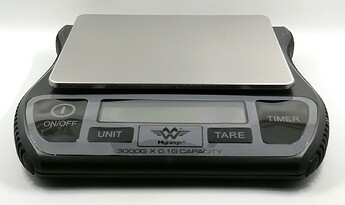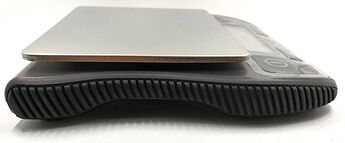Gear review: Scales
First, let me point out some features that I’m looking for in a coffee scale.
(1) I need the ability to disable the auto shut-off feature which can become extremely annoying for manual coffee brewing.
(2) I’m looking for resolution better than 1g. I’ll note that resolution != accuracy, but in general I’ve found that the accuracy of most scales seems to be +/- a unit of resolution. There’s generally a trade-off between resolution and maximum capacity, which leads me to…
(3) The maximum capacity needs to be large enough to fit all of your gear. My V60 setup comes out to about 800g total for single dosing, but that doesn’t mean I’d go for a scale with a 1,000g capacity–I want more overhead than that to allow for possibility of larger batches or heavier equipment. My min requirement was ~2,000g.
(4) The readout speed should be fast. By that I mean when you’re pouring water, you want the weight to update nearly immediately. I’ve used cheap scales that lag behind by hundreds to thousands of milliseconds which I want to avoid.
Both scales I’m reviewing meet these requirements. I should also mention that both have plastic cover plates that protect the load cells when the units are not in operation.
MyWeigh Barista (price paid: $37.50)
I’ve been using this MyWeigh scale daily for about a year now. The first thing I’ll note is that it’s pretty small and really an espresso scale: both my Hario kettle and Chemex hang over the edges of the plate which slightly hurts readability. It has a max capacity of 3,000g with 0.1g resolution. That kind of resolution is really nice for single dosing and retention. It has a backlit negative LCD display that’s high contrast and easy to read. Unit modes include g, oz, lbs, lbs:oz, and pieces. It has a timer function aimed at espresso I’ve found to be useless for pour-over coffee.
Build quality: Stainless steel plate. The main body is fairly uninspiring plastic but you mostly contact the rubberized ridges on the side that provide a secure grip. The membrane cover for the controls/display is a thin plastic that peeled up slightly on one corner. That’s disappointing but it doesn’t seem to have affected the functionality. The buttons are responsive and have a satisfying click. This unit has a lithium-ion battery that holds a charge forever. I think I’ve charged it two or three times total (micro USB). I read that this model has been discontinued due to some drift issue in the load cell, but I haven’t had any problems. That said, I wouldn’t pay more than $40 although the original list price was about double that.
J-Scale (Jennings) CJ-4000 (price paid: $29)
This is the classic scale that is frequently recommended for pour-over that I picked up more recently. It is larger than the MyWeigh and has a round plate that’s perfect for coffee vessels like a Chemex or glass decanter. The plate also sits farther away from the display/controls allowing easier readout and operation. The backlit display is black on very bright orange which is extremely readable. I think the modes are the same with g, oz, lb, pcs. Scale capacity is 4,000g with a resolution of 0.5g.
Build quality: Stainless steel plate. Body is even cheaper plastic than the MyWeigh and is more uninspiring somehow. This unit feels lighter to me despite being larger. It’s not nearly as nice to touch or operate. It runs off 3 AAA batteries or the included AC adapter. Now for the worst part. This scale makes an annoyingly loud beep on every button press and cannot be disabled without modding the pcb. Seriously what the fuck?
Verdict: Neither unit is perfect for my purpose. However, I find myself still using the MyWeigh. The J-Scale is nicer for pouring water but that’s about it. Once I disable the awful speaker I may use it more. It also takes up more counter space which is a negative. The Hario Drip Scale is another option but it’s pretty expensive in stainless and seems to have reliability issues.
Buying recs: I am somewhat hesitant to recommend either of these units, but the MyWeigh is my pick under $40 if the plate (3.8″ x 4.7″) is large enough for your brew method. Surely both are considerably better than the cheapest garbage tier units you’d find at Amazon/Walmart. Even though I’m not particularly high on these scales, I’ve used much, much worse before. One thing I’ve learned is that there are tons of other scales out there that may be suitable for coffee but aren’t marketed as such. I’d stick with known/reputable scale manufacturers and look for 0.1g resolution with high max capacity.



